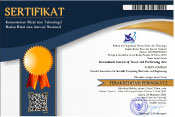(2) Gautam Hegde
*corresponding author
AbstractMany of the Indian performing arts have deep scientific/engineering aspects involved in them without being recognised or studied. Yakshagana is one of such arts being performed in coastal districts of Karnataka and has a history of more than 500 years. Yakshagana is a team, multidisciplinary art involving classical music, percussions, dance, dialogue, comedy, costumes, and scholarly discussions. This article discusses the components/parameters of the Yakshagana art form from a scientific and engineering perspective, and we have attempted to formulate mathematical equations for a better understanding of the art execution, artist’s capacity and overall performance. Empirical mathematical relations are formulated to estimate the performance index to grade the quality of the overall performance of the day. As art is an “all-in-one†form of art performance, it is represented using a Venn diagram. Four main components of Yakshagana and the importance of the coordination between them for successful, cohesive and high-quality performance are analysed by incorporating scientific and engineering approaches. We hope that the present study will open up further scientific research on long-duration performing Indian traditional art forms
KeywordsYakshagana; Yakshagana Science; All-in-one art; Performance index; Rangasthala
|
DOIhttps://doi.org/10.31763/viperarts.v4i2.742 |
Article metrics10.31763/viperarts.v4i2.742 Abstract views : 2310 | PDF views : 811 |
Cite |
Full Text Download Download
|
References
[1] K. S. Upadhyaya, “Yakshagana Bayalata.†Sangeet Natak Akademi, New Delhi, 1969. Available at: Google Scholar
[2] J. Kala, “Philosophy of Spiritual Evolution in Karnad’s Play Hayavadana,†Motifs A Peer Rev. Int. J. English Stud., vol. 8, no. 1, pp. 1–9, 2022. doi: 10.5958/2454-1753.2022.00001.0
[3] S. L. Leiter, “The Theatres of Asia: An Introduction,†Asian Theatr. J., vol. 21, no. 2, pp. 231–233, 2004. doi: 10.1353/atj.2004.0017
[4] M. B. Ashton-Sikora and B. Christie, Yaká¹£agÄna, a Dance Drama of India. Abhinav Publications, 1977. Available at: Google Scholar
[5] S. Soni, “Mapping the Dark One: Krishna in the Mahabharat Stories1,†Interdisciplinary Alter-natives in Comparative Literature. SAGE Publications India, p. 199, 2013. Available at: Google Scholar
[6] P. Bilimale, “The Making of Ramayana in the Yakshagana of Coastal Karnataka,†Multivalence an Epic Retelling Ramayana South India Southeast Asia, vol. 7, p. 316, 2021. Available at: Google Books
[7] P. Richman, Ramayana stories in modern South India: An anthology. USA: Indiana University Press, 2008. Available at: Google Scholar
[8] K. Binder, “A World of Many Colours: yaká¹£agÄna rangabhÅ«mi,†Cracow Indol. Stud., vol. 18, no. 18, pp. 3–21, 2016, doi: 10.12797/CIS.18.2016.18.02.
[9] B. Gururao, “Semantics of Yakshagana: Yakshagana performance and meaning a semantic study.†Regional Resources for Folk Performing Arts, Kunjibettu, Udupi, 1998. Available at: Google Scholar
[10] A. Lal, The Oxford companion to Indian theatre. USA: Oxford University Press, 2004. Available at: Google Scholar
[11] M. Gadgil and P. R. Seshagiri Rao, Nurturing biodiversity. Centre for Environment Education, 1998. Available at: Google Scholar
[12] M. Gadgil, B. Krishnan, V. Vijayan, R. Borges, R. Sukumar, and G. Subrahmanyam, “Report of the Western Ghats Ecology Expert Panel,†The Ministry of Environment and Forests, Government of India, vol. 29. 2015. Available at: Google Scholar
[13] K. V Padmanabha and S. Kumar, “Folk Media for Agricultural Extension: A Study of Yakshagana A South Indian Folk Theatre",†IJASSH. 2020. Available at: Google Scholar
[14] K. V Padmanabha and S. Kumar, “Modern themes in Yakshagana: Experimentation and relevance,†Int. J. Res. Anal. Rev., vol. 6, no. 2, pp. 395–401, 2019. Available at: Google Scholar
[15] P. Kabbinahithilu Venkataramana and S. Kumar, “Effectiveness of folk theatre in conveying environmental consciousness: a case study of Yakshagana,†Media Asia, vol. 49, no. 2, pp. 111–129, 2022. doi: 10.1080/01296612.2021.2005961
[16] M. M. B. Ashton, Yakshagana badagatittu bayalata: a South Indian dance drama. USA: Michigan State University, 1972. Available at: Google Scholar
[17] S. T. Hegde, “Yakshagana sangeeta ondu adhyayana.†Dharwad, India, 1999. Available at: Google Scholar
[18] P. S. Kalaisevi and M. Jayaram, “Analysis of voice in Yakshagana folk artists.†PhD thesis, India, 2009. Available at: Google Scholar
[19] D. R. Gunjawate, V. U. Aithal, U. Devadas, and V. Guddattu, “Evaluation of Singing Vocal Health in Yakshagana Singers,†J. Voice, vol. 31, no. 2, pp. 253.e13–253.e16, Mar. 2017, doi: 10.1016/j.jvoice.2016.06.022.
[20] U. Devadas, M. Hegde, and S. Maruthy, “Prevalence and Risk Factors of Self-reported Voice Problems Among Yakshagana Artists,†J. Voice, vol. 33, no. 1, pp. 124.e35–124.e47, Jan. 2019, doi: 10.1016/j.jvoice.2017.09.010.
[21] D. R. Gunjawate, V. Aithal U, and R. Bellur, “Adaptation and Validation of the Kannada Singing Voice Handicap Index-10,†J. Voice, vol. 33, no. 4, pp. 582.e1–582.e4, Jul. 2019, doi: 10.1016/j.jvoice.2018.02.005.
[22] L. Jing and W. Xudong, “Evaluation on the effects of relaxing music on the recovery from aerobic exercise-induced fatigue,†J. Sports Med. Phys. Fitness, vol. 48, no. 1, pp. 102–106, 2008. Available at: Google Scholar
[23] A. K. Goyal, G. Yadav, and S. Yadav, “Music Therapy: A Useful Therapeutic Tool for Health, Physical and Mental Growth,†lnternational J. Music Ther., vol. 2, no. 1–2, pp. 13–18, 2012. Available at: Google Scholar
[24] K. Thyagarajan and A. Ghatak, Lasers: fundamentals and applications. London: Springer Science & Business Media, 2010. Available at: Google Books
Refbacks
- There are currently no refbacks.
Copyright (c) 2022 Gopalkrishna Hegde

This work is licensed under a Creative Commons Attribution-ShareAlike 4.0 International License.
___________________________________________________________
International Journal of Visual and Performing Arts
ISSN 2684-9259
Published by Association for Scientific Computing Electronics and Engineering (ASCEE)
W: http://pubs2.ascee.org/index.php/viperarts
E: sularso@ascee.org
Organized by:
 This work is licensed under a Creative Commons Attribution-ShareAlike 4.0
This work is licensed under a Creative Commons Attribution-ShareAlike 4.0
























